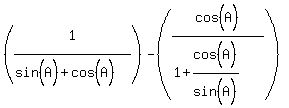


We work with the left side:
 Let s = sin(A)
Let c = cos(A)
Let s = sin(A)
Let c = cos(A)
 Factor numerator as the sum of two cubes
and the trinomial in the denominator
Factor numerator as the sum of two cubes
and the trinomial in the denominator
 Cancel the (s+c)'s
Cancel the (s+c)'s

 Replace s and c by what we let them be above:
Replace s and c by what we let them be above:
 By a well known identity, looking at the first
and third terms, the numerator becomes
By a well known identity, looking at the first
and third terms, the numerator becomes
 We break that into two fractions:
We break that into two fractions:
 In the second fraction, divide every term,
top and bottom by sin(A)
In the second fraction, divide every term,
top and bottom by sin(A)
 Cancel the sin(A)'s in the top, and the sin(A)'s in the bottom
Cancel the sin(A)'s in the top, and the sin(A)'s in the bottom

 By using a well-known identity for cot(A):
By using a well-known identity for cot(A):
 Edwin
Edwin